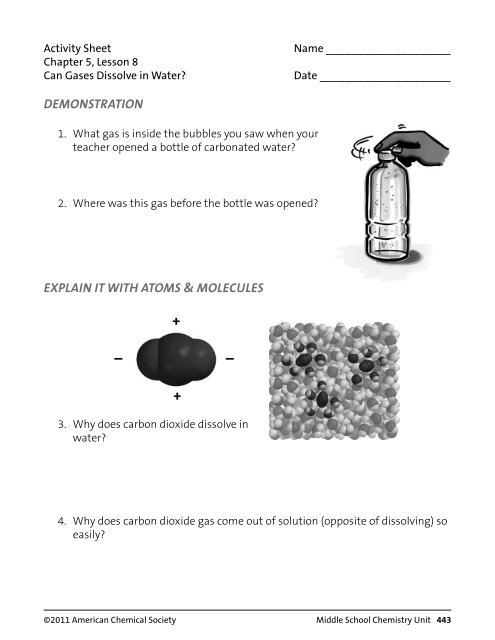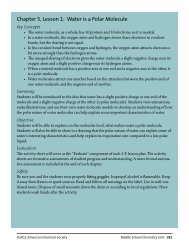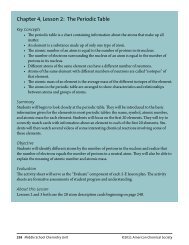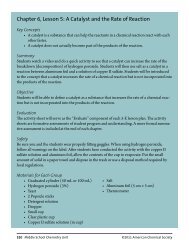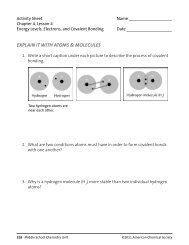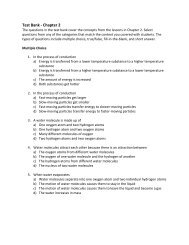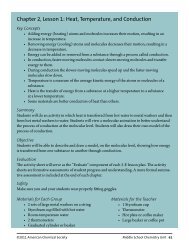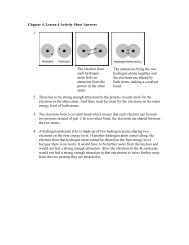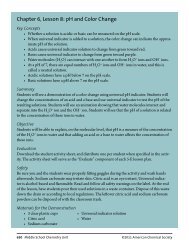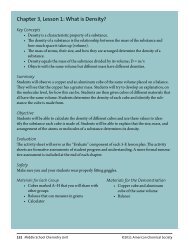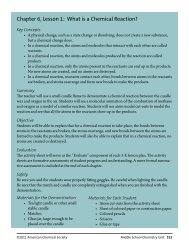Activity Sheet - Middle School Chemistry
Activity Sheet - Middle School Chemistry
Activity Sheet - Middle School Chemistry
You also want an ePaper? Increase the reach of your titles
YUMPU automatically turns print PDFs into web optimized ePapers that Google loves.
<strong>Activity</strong> <strong>Sheet</strong><br />
Chapter 5, Lesson 8<br />
Can Gases Dissolve in Water<br />
Name ____________________<br />
Date _____________________<br />
DEMONSTRATION<br />
1.<br />
What gas is inside the bubbles you saw when your<br />
teacher opened a bottle of carbonated water<br />
2.<br />
Where was this gas before the bottle was opened<br />
EXPLAIN IT WITH ATOMS & MOLECULES<br />
+<br />
–<br />
–<br />
+<br />
3.<br />
Why does carbon dioxide dissolve in<br />
water<br />
4.<br />
Why does carbon dioxide gas come out of solution (opposite of dissolving) so<br />
easily<br />
©2011 American Chemical Society <strong>Middle</strong> <strong>School</strong> <strong>Chemistry</strong> Unit 443
ACTIVITY<br />
Question to Investigate<br />
How can you make carbon dioxide gas come out of solution<br />
Materials for Each Group<br />
• Club soda in clear plastic cup<br />
• 2 clear plastic cups<br />
• M&M<br />
• Pipe cleaner<br />
Procedure<br />
1. Evenly divide the club soda among the 3 clear plastic cups.<br />
Push two of these cups aside to use later.<br />
2. Place a pipe cleaner in the soda and observe.<br />
3. Place an M&M in the soda and observe.<br />
5. What was it about the pipe cleaner and M&M that<br />
caused bubbles to form<br />
6. While drinking soda pop with a straw, you may have noticed that bubbles<br />
form on the outside of the straw. Now that you have done this activity, why<br />
do you think these bubbles form on the straw<br />
444 <strong>Middle</strong> <strong>School</strong> <strong>Chemistry</strong> Unit ©2011 American Chemical Society
ACTIVITY<br />
Question to Investigate<br />
Does carbon dioxide stay dissolved better in water that is warmed or<br />
water that is cooled<br />
Materials for Each Group<br />
• Carbonated water in 2 clear plastic cups<br />
• Hot water (about 50 °C)<br />
• Cold water (about 5 °C)<br />
• 2 deli containers (that cups easily fit in)<br />
Procedure<br />
1. Get the two cups of carbonated water that you moved aside earlier.<br />
2. Fill one empty deli container about ⅓ of the way with ice cold water and another<br />
about ⅓ of the way with hot tap water.<br />
3. Place each of the cups of carbonated water into the cold and hot water, as shown.<br />
4. Watch the surface of the soda in each cup of carbonated water.<br />
7. Does carbon dioxide stay dissolved better in hot water or in cold water<br />
How do you know<br />
©2011 American Chemical Society <strong>Middle</strong> <strong>School</strong> <strong>Chemistry</strong> Unit 445
8. Based on what you observed in this experiment, why do you think people<br />
store soda pop in the refrigerator after the bottle has been opened<br />
EXPLAIN IT WITH ATOMS & MOLECULES<br />
9. Why does warming carbonated water make it easier for carbon dioxide to<br />
come out of solution<br />
10. Look at the graph showing the solubility of carbon dioxide in water to answer<br />
the following questions.<br />
As the temperature increases, is carbon dioxide more soluble in water or less<br />
soluble in water<br />
Does this graph match or<br />
not match your observations<br />
Explain.<br />
Solubility (g/100 g water)<br />
0.35<br />
0.3<br />
0.25<br />
0.2<br />
0.15<br />
0.1<br />
0.05<br />
0 0.32<br />
10 0.24<br />
20 0.17<br />
30 0.13<br />
40 0.1<br />
50 0.08<br />
60 0.06<br />
Carbon dioxide solubility in water<br />
0<br />
0 10 20 30 40 50 60<br />
Temperature (C)<br />
446 <strong>Middle</strong> <strong>School</strong> <strong>Chemistry</strong> Unit ©2011 American Chemical Society
11. What do the graphs below tell you about the solubility of carbon dioxide<br />
compared to sucrose, as temperature increases<br />
Solubility (g/100 g water)<br />
0.35<br />
0.3<br />
0.25<br />
0.2<br />
0.15<br />
0.1<br />
0.05<br />
0 0.32<br />
10 0.24<br />
20 0.17<br />
30 0.13<br />
40 0.1<br />
50 0.08<br />
60 0.06<br />
Carbon dioxide solubility in water<br />
0<br />
0 10 20 30 40 50 60<br />
Temperature (C)<br />
Solubility of salt and sugar<br />
Grams of salt or sugar<br />
dissolved in 100 ml water<br />
500<br />
450<br />
400<br />
350<br />
300<br />
250<br />
200<br />
150<br />
100<br />
50<br />
Sugar<br />
Salt<br />
0 20 40 60 80 100<br />
Temperature (°C)<br />
TAKE IT FURTHER<br />
12. During a long hot summer, you may notice fish gulping air at the surface of<br />
a pond. Why do you think the fish come to the surface like this, instead of<br />
breathing dissolved oxygen in the water the way that they normally do<br />
13. Coal-burning power plants heat water to turn turbines to make electricity.<br />
After using the water, it is cooled and then returned to the river or lake it<br />
came from. Why is it important to cool the water before returning it to the<br />
river<br />
©2011 American Chemical Society <strong>Middle</strong> <strong>School</strong> <strong>Chemistry</strong> Unit 447
14. What causes the fantastic “fountain” when a roll of Mentos mints is dropped<br />
in a bottle of Diet Coke<br />
448 <strong>Middle</strong> <strong>School</strong> <strong>Chemistry</strong> Unit ©2011 American Chemical Society


